Intensive Interaction: Improving Communication in Learners Report
VerifiedAdded on 2022/12/02
|21
|5784
|233
Report
AI Summary
This report provides a comprehensive overview of Intensive Interaction as a communication intervention, particularly for learners with Severe Learning Disability (SLD), Profound and Multiple Learning Disabilities (PMLD), and Autism Spectrum Disorder (ASD). The report begins with an introduction outlining the author's personal experience and passion for working with children with disabilities. A thorough literature review explores various communication theories, including models by Charles, Schramm, and Aristotle, highlighting the importance of both linguistic and non-linguistic means of communication. The report then defines Intensive Interaction, tracing its origins and emphasizing its role in fostering communication and socialization skills. It discusses theories supporting Intensive Interaction, such as 'augmented mothering,' attachment theory, and Vygotsky's sociocultural theory. Although the report primarily consists of a literature review, it includes a section on research methodology outlining the qualitative approach, inductive research methods, and interpretivism philosophy used in the study. While data collection was not possible due to COVID-19, the report reflects on the intervention's alignment with theory and policy and offers recommendations for practice and further research. The report concludes with a discussion of the importance of Intensive Interaction in improving learners' independence, self-esteem, and quality of life.

INTENSIVE INTERACTION
Paraphrase This Document
Need a fresh take? Get an instant paraphrase of this document with our AI Paraphraser
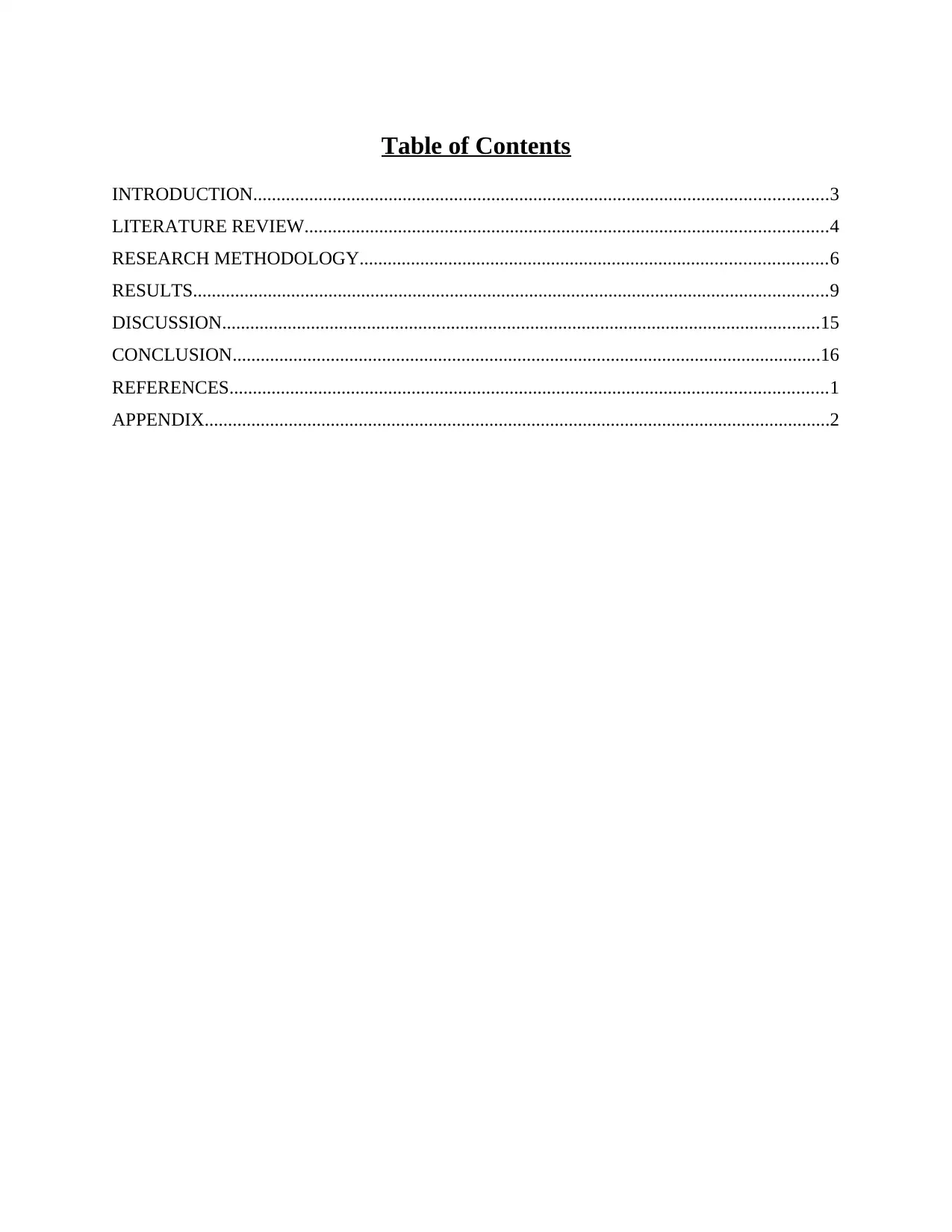
Table of Contents
INTRODUCTION...........................................................................................................................3
LITERATURE REVIEW................................................................................................................4
RESEARCH METHODOLOGY....................................................................................................6
RESULTS........................................................................................................................................9
DISCUSSION................................................................................................................................15
CONCLUSION..............................................................................................................................16
REFERENCES................................................................................................................................1
APPENDIX......................................................................................................................................2
INTRODUCTION...........................................................................................................................3
LITERATURE REVIEW................................................................................................................4
RESEARCH METHODOLOGY....................................................................................................6
RESULTS........................................................................................................................................9
DISCUSSION................................................................................................................................15
CONCLUSION..............................................................................................................................16
REFERENCES................................................................................................................................1
APPENDIX......................................................................................................................................2
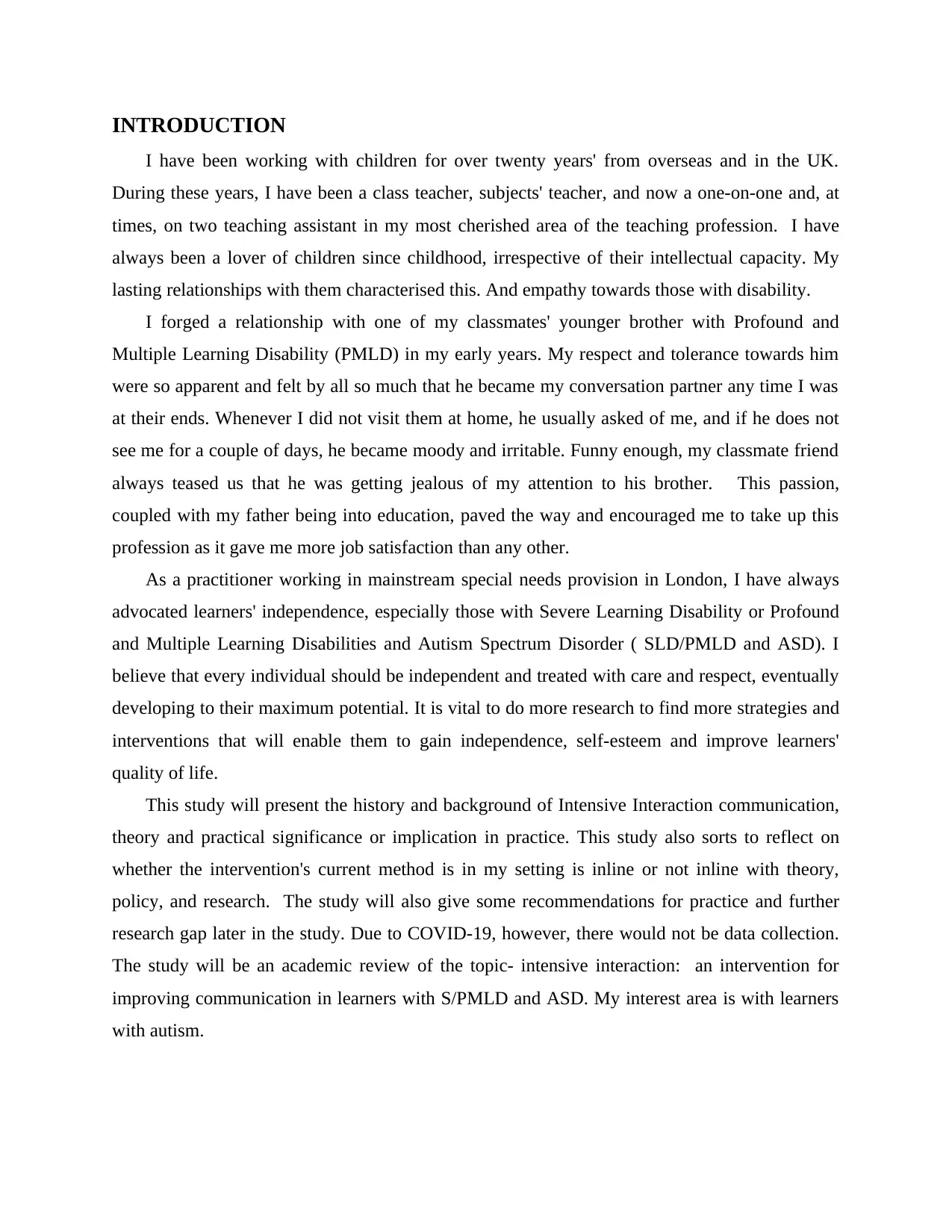
INTRODUCTION
I have been working with children for over twenty years' from overseas and in the UK.
During these years, I have been a class teacher, subjects' teacher, and now a one-on-one and, at
times, on two teaching assistant in my most cherished area of the teaching profession. I have
always been a lover of children since childhood, irrespective of their intellectual capacity. My
lasting relationships with them characterised this. And empathy towards those with disability.
I forged a relationship with one of my classmates' younger brother with Profound and
Multiple Learning Disability (PMLD) in my early years. My respect and tolerance towards him
were so apparent and felt by all so much that he became my conversation partner any time I was
at their ends. Whenever I did not visit them at home, he usually asked of me, and if he does not
see me for a couple of days, he became moody and irritable. Funny enough, my classmate friend
always teased us that he was getting jealous of my attention to his brother. This passion,
coupled with my father being into education, paved the way and encouraged me to take up this
profession as it gave me more job satisfaction than any other.
As a practitioner working in mainstream special needs provision in London, I have always
advocated learners' independence, especially those with Severe Learning Disability or Profound
and Multiple Learning Disabilities and Autism Spectrum Disorder ( SLD/PMLD and ASD). I
believe that every individual should be independent and treated with care and respect, eventually
developing to their maximum potential. It is vital to do more research to find more strategies and
interventions that will enable them to gain independence, self-esteem and improve learners'
quality of life.
This study will present the history and background of Intensive Interaction communication,
theory and practical significance or implication in practice. This study also sorts to reflect on
whether the intervention's current method is in my setting is inline or not inline with theory,
policy, and research. The study will also give some recommendations for practice and further
research gap later in the study. Due to COVID-19, however, there would not be data collection.
The study will be an academic review of the topic- intensive interaction: an intervention for
improving communication in learners with S/PMLD and ASD. My interest area is with learners
with autism.
I have been working with children for over twenty years' from overseas and in the UK.
During these years, I have been a class teacher, subjects' teacher, and now a one-on-one and, at
times, on two teaching assistant in my most cherished area of the teaching profession. I have
always been a lover of children since childhood, irrespective of their intellectual capacity. My
lasting relationships with them characterised this. And empathy towards those with disability.
I forged a relationship with one of my classmates' younger brother with Profound and
Multiple Learning Disability (PMLD) in my early years. My respect and tolerance towards him
were so apparent and felt by all so much that he became my conversation partner any time I was
at their ends. Whenever I did not visit them at home, he usually asked of me, and if he does not
see me for a couple of days, he became moody and irritable. Funny enough, my classmate friend
always teased us that he was getting jealous of my attention to his brother. This passion,
coupled with my father being into education, paved the way and encouraged me to take up this
profession as it gave me more job satisfaction than any other.
As a practitioner working in mainstream special needs provision in London, I have always
advocated learners' independence, especially those with Severe Learning Disability or Profound
and Multiple Learning Disabilities and Autism Spectrum Disorder ( SLD/PMLD and ASD). I
believe that every individual should be independent and treated with care and respect, eventually
developing to their maximum potential. It is vital to do more research to find more strategies and
interventions that will enable them to gain independence, self-esteem and improve learners'
quality of life.
This study will present the history and background of Intensive Interaction communication,
theory and practical significance or implication in practice. This study also sorts to reflect on
whether the intervention's current method is in my setting is inline or not inline with theory,
policy, and research. The study will also give some recommendations for practice and further
research gap later in the study. Due to COVID-19, however, there would not be data collection.
The study will be an academic review of the topic- intensive interaction: an intervention for
improving communication in learners with S/PMLD and ASD. My interest area is with learners
with autism.
⊘ This is a preview!⊘
Do you want full access?
Subscribe today to unlock all pages.

Trusted by 1+ million students worldwide
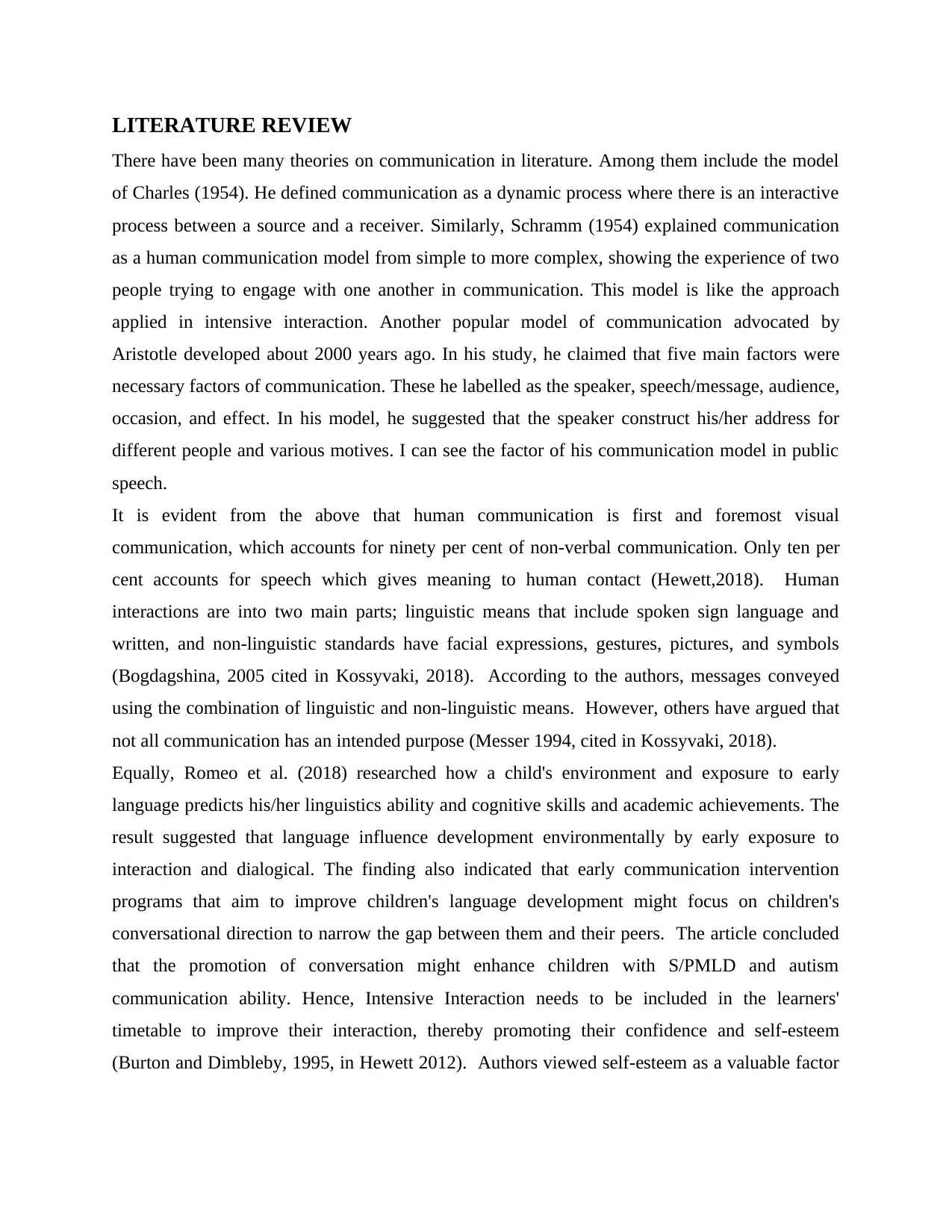
LITERATURE REVIEW
There have been many theories on communication in literature. Among them include the model
of Charles (1954). He defined communication as a dynamic process where there is an interactive
process between a source and a receiver. Similarly, Schramm (1954) explained communication
as a human communication model from simple to more complex, showing the experience of two
people trying to engage with one another in communication. This model is like the approach
applied in intensive interaction. Another popular model of communication advocated by
Aristotle developed about 2000 years ago. In his study, he claimed that five main factors were
necessary factors of communication. These he labelled as the speaker, speech/message, audience,
occasion, and effect. In his model, he suggested that the speaker construct his/her address for
different people and various motives. I can see the factor of his communication model in public
speech.
It is evident from the above that human communication is first and foremost visual
communication, which accounts for ninety per cent of non-verbal communication. Only ten per
cent accounts for speech which gives meaning to human contact (Hewett,2018). Human
interactions are into two main parts; linguistic means that include spoken sign language and
written, and non-linguistic standards have facial expressions, gestures, pictures, and symbols
(Bogdagshina, 2005 cited in Kossyvaki, 2018). According to the authors, messages conveyed
using the combination of linguistic and non-linguistic means. However, others have argued that
not all communication has an intended purpose (Messer 1994, cited in Kossyvaki, 2018).
Equally, Romeo et al. (2018) researched how a child's environment and exposure to early
language predicts his/her linguistics ability and cognitive skills and academic achievements. The
result suggested that language influence development environmentally by early exposure to
interaction and dialogical. The finding also indicated that early communication intervention
programs that aim to improve children's language development might focus on children's
conversational direction to narrow the gap between them and their peers. The article concluded
that the promotion of conversation might enhance children with S/PMLD and autism
communication ability. Hence, Intensive Interaction needs to be included in the learners'
timetable to improve their interaction, thereby promoting their confidence and self-esteem
(Burton and Dimbleby, 1995, in Hewett 2012). Authors viewed self-esteem as a valuable factor
There have been many theories on communication in literature. Among them include the model
of Charles (1954). He defined communication as a dynamic process where there is an interactive
process between a source and a receiver. Similarly, Schramm (1954) explained communication
as a human communication model from simple to more complex, showing the experience of two
people trying to engage with one another in communication. This model is like the approach
applied in intensive interaction. Another popular model of communication advocated by
Aristotle developed about 2000 years ago. In his study, he claimed that five main factors were
necessary factors of communication. These he labelled as the speaker, speech/message, audience,
occasion, and effect. In his model, he suggested that the speaker construct his/her address for
different people and various motives. I can see the factor of his communication model in public
speech.
It is evident from the above that human communication is first and foremost visual
communication, which accounts for ninety per cent of non-verbal communication. Only ten per
cent accounts for speech which gives meaning to human contact (Hewett,2018). Human
interactions are into two main parts; linguistic means that include spoken sign language and
written, and non-linguistic standards have facial expressions, gestures, pictures, and symbols
(Bogdagshina, 2005 cited in Kossyvaki, 2018). According to the authors, messages conveyed
using the combination of linguistic and non-linguistic means. However, others have argued that
not all communication has an intended purpose (Messer 1994, cited in Kossyvaki, 2018).
Equally, Romeo et al. (2018) researched how a child's environment and exposure to early
language predicts his/her linguistics ability and cognitive skills and academic achievements. The
result suggested that language influence development environmentally by early exposure to
interaction and dialogical. The finding also indicated that early communication intervention
programs that aim to improve children's language development might focus on children's
conversational direction to narrow the gap between them and their peers. The article concluded
that the promotion of conversation might enhance children with S/PMLD and autism
communication ability. Hence, Intensive Interaction needs to be included in the learners'
timetable to improve their interaction, thereby promoting their confidence and self-esteem
(Burton and Dimbleby, 1995, in Hewett 2012). Authors viewed self-esteem as a valuable factor
Paraphrase This Document
Need a fresh take? Get an instant paraphrase of this document with our AI Paraphraser
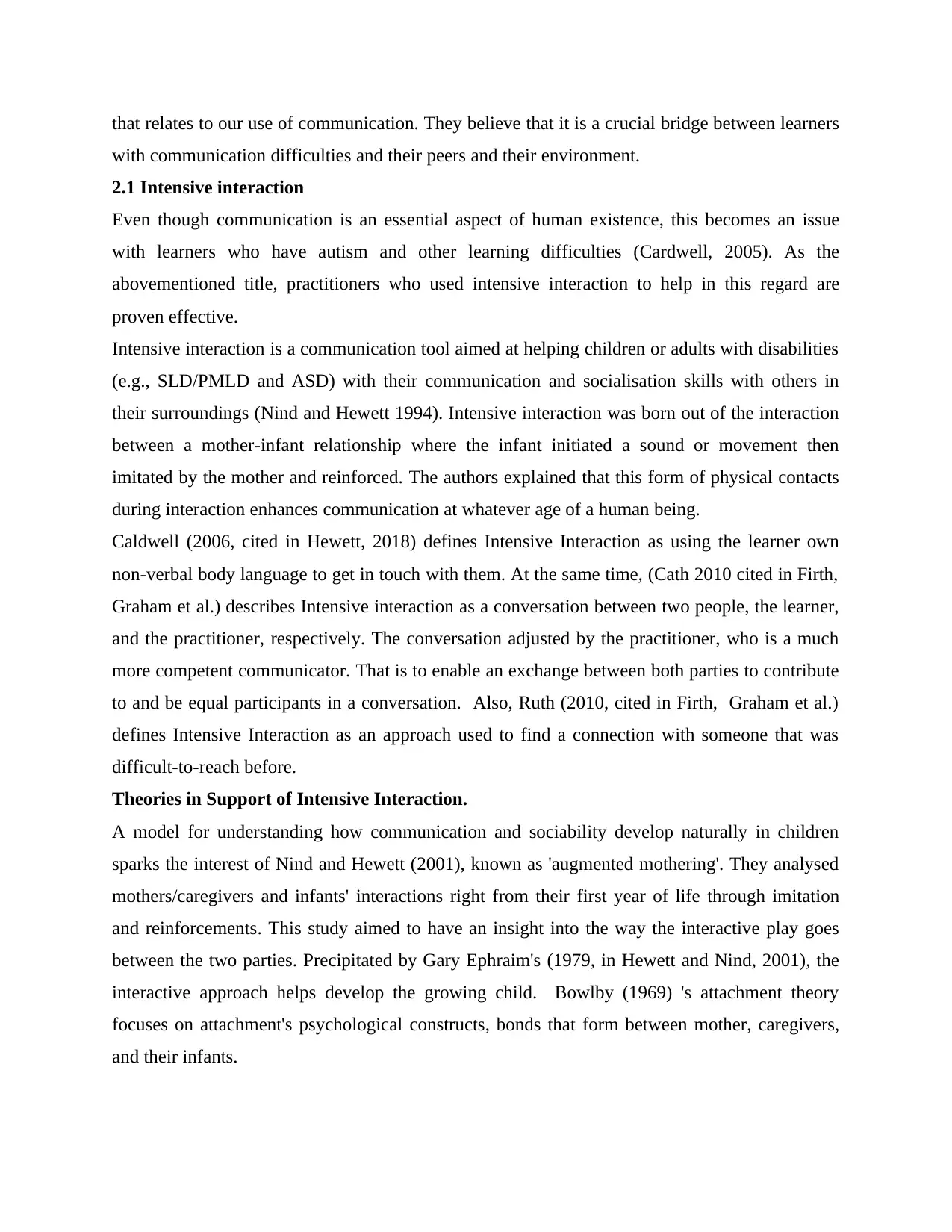
that relates to our use of communication. They believe that it is a crucial bridge between learners
with communication difficulties and their peers and their environment.
2.1 Intensive interaction
Even though communication is an essential aspect of human existence, this becomes an issue
with learners who have autism and other learning difficulties (Cardwell, 2005). As the
abovementioned title, practitioners who used intensive interaction to help in this regard are
proven effective.
Intensive interaction is a communication tool aimed at helping children or adults with disabilities
(e.g., SLD/PMLD and ASD) with their communication and socialisation skills with others in
their surroundings (Nind and Hewett 1994). Intensive interaction was born out of the interaction
between a mother-infant relationship where the infant initiated a sound or movement then
imitated by the mother and reinforced. The authors explained that this form of physical contacts
during interaction enhances communication at whatever age of a human being.
Caldwell (2006, cited in Hewett, 2018) defines Intensive Interaction as using the learner own
non-verbal body language to get in touch with them. At the same time, (Cath 2010 cited in Firth,
Graham et al.) describes Intensive interaction as a conversation between two people, the learner,
and the practitioner, respectively. The conversation adjusted by the practitioner, who is a much
more competent communicator. That is to enable an exchange between both parties to contribute
to and be equal participants in a conversation. Also, Ruth (2010, cited in Firth, Graham et al.)
defines Intensive Interaction as an approach used to find a connection with someone that was
difficult-to-reach before.
Theories in Support of Intensive Interaction.
A model for understanding how communication and sociability develop naturally in children
sparks the interest of Nind and Hewett (2001), known as 'augmented mothering'. They analysed
mothers/caregivers and infants' interactions right from their first year of life through imitation
and reinforcements. This study aimed to have an insight into the way the interactive play goes
between the two parties. Precipitated by Gary Ephraim's (1979, in Hewett and Nind, 2001), the
interactive approach helps develop the growing child. Bowlby (1969) 's attachment theory
focuses on attachment's psychological constructs, bonds that form between mother, caregivers,
and their infants.
with communication difficulties and their peers and their environment.
2.1 Intensive interaction
Even though communication is an essential aspect of human existence, this becomes an issue
with learners who have autism and other learning difficulties (Cardwell, 2005). As the
abovementioned title, practitioners who used intensive interaction to help in this regard are
proven effective.
Intensive interaction is a communication tool aimed at helping children or adults with disabilities
(e.g., SLD/PMLD and ASD) with their communication and socialisation skills with others in
their surroundings (Nind and Hewett 1994). Intensive interaction was born out of the interaction
between a mother-infant relationship where the infant initiated a sound or movement then
imitated by the mother and reinforced. The authors explained that this form of physical contacts
during interaction enhances communication at whatever age of a human being.
Caldwell (2006, cited in Hewett, 2018) defines Intensive Interaction as using the learner own
non-verbal body language to get in touch with them. At the same time, (Cath 2010 cited in Firth,
Graham et al.) describes Intensive interaction as a conversation between two people, the learner,
and the practitioner, respectively. The conversation adjusted by the practitioner, who is a much
more competent communicator. That is to enable an exchange between both parties to contribute
to and be equal participants in a conversation. Also, Ruth (2010, cited in Firth, Graham et al.)
defines Intensive Interaction as an approach used to find a connection with someone that was
difficult-to-reach before.
Theories in Support of Intensive Interaction.
A model for understanding how communication and sociability develop naturally in children
sparks the interest of Nind and Hewett (2001), known as 'augmented mothering'. They analysed
mothers/caregivers and infants' interactions right from their first year of life through imitation
and reinforcements. This study aimed to have an insight into the way the interactive play goes
between the two parties. Precipitated by Gary Ephraim's (1979, in Hewett and Nind, 2001), the
interactive approach helps develop the growing child. Bowlby (1969) 's attachment theory
focuses on attachment's psychological constructs, bonds that form between mother, caregivers,
and their infants.
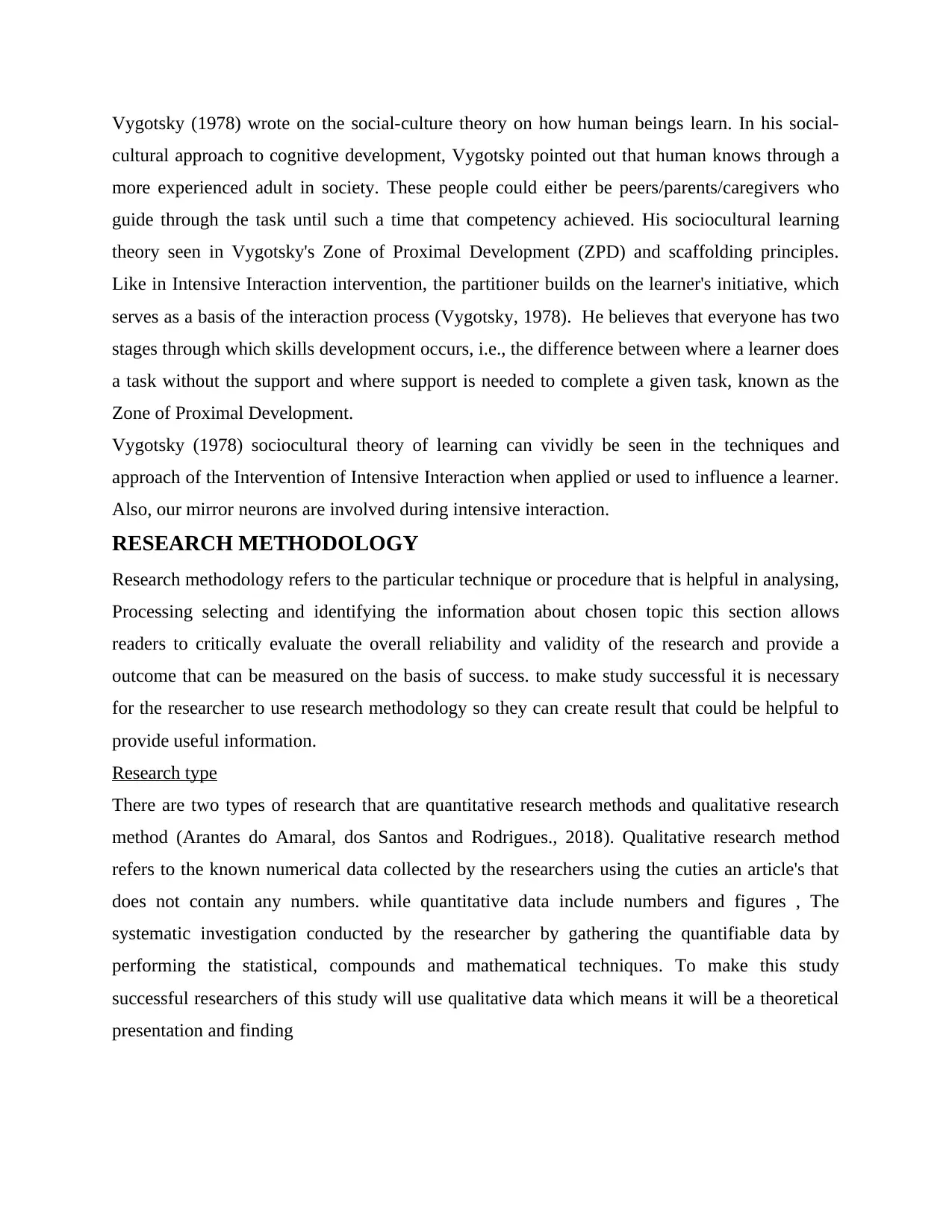
Vygotsky (1978) wrote on the social-culture theory on how human beings learn. In his social-
cultural approach to cognitive development, Vygotsky pointed out that human knows through a
more experienced adult in society. These people could either be peers/parents/caregivers who
guide through the task until such a time that competency achieved. His sociocultural learning
theory seen in Vygotsky's Zone of Proximal Development (ZPD) and scaffolding principles.
Like in Intensive Interaction intervention, the partitioner builds on the learner's initiative, which
serves as a basis of the interaction process (Vygotsky, 1978). He believes that everyone has two
stages through which skills development occurs, i.e., the difference between where a learner does
a task without the support and where support is needed to complete a given task, known as the
Zone of Proximal Development.
Vygotsky (1978) sociocultural theory of learning can vividly be seen in the techniques and
approach of the Intervention of Intensive Interaction when applied or used to influence a learner.
Also, our mirror neurons are involved during intensive interaction.
RESEARCH METHODOLOGY
Research methodology refers to the particular technique or procedure that is helpful in analysing,
Processing selecting and identifying the information about chosen topic this section allows
readers to critically evaluate the overall reliability and validity of the research and provide a
outcome that can be measured on the basis of success. to make study successful it is necessary
for the researcher to use research methodology so they can create result that could be helpful to
provide useful information.
Research type
There are two types of research that are quantitative research methods and qualitative research
method (Arantes do Amaral, dos Santos and Rodrigues., 2018). Qualitative research method
refers to the known numerical data collected by the researchers using the cuties an article's that
does not contain any numbers. while quantitative data include numbers and figures , The
systematic investigation conducted by the researcher by gathering the quantifiable data by
performing the statistical, compounds and mathematical techniques. To make this study
successful researchers of this study will use qualitative data which means it will be a theoretical
presentation and finding
cultural approach to cognitive development, Vygotsky pointed out that human knows through a
more experienced adult in society. These people could either be peers/parents/caregivers who
guide through the task until such a time that competency achieved. His sociocultural learning
theory seen in Vygotsky's Zone of Proximal Development (ZPD) and scaffolding principles.
Like in Intensive Interaction intervention, the partitioner builds on the learner's initiative, which
serves as a basis of the interaction process (Vygotsky, 1978). He believes that everyone has two
stages through which skills development occurs, i.e., the difference between where a learner does
a task without the support and where support is needed to complete a given task, known as the
Zone of Proximal Development.
Vygotsky (1978) sociocultural theory of learning can vividly be seen in the techniques and
approach of the Intervention of Intensive Interaction when applied or used to influence a learner.
Also, our mirror neurons are involved during intensive interaction.
RESEARCH METHODOLOGY
Research methodology refers to the particular technique or procedure that is helpful in analysing,
Processing selecting and identifying the information about chosen topic this section allows
readers to critically evaluate the overall reliability and validity of the research and provide a
outcome that can be measured on the basis of success. to make study successful it is necessary
for the researcher to use research methodology so they can create result that could be helpful to
provide useful information.
Research type
There are two types of research that are quantitative research methods and qualitative research
method (Arantes do Amaral, dos Santos and Rodrigues., 2018). Qualitative research method
refers to the known numerical data collected by the researchers using the cuties an article's that
does not contain any numbers. while quantitative data include numbers and figures , The
systematic investigation conducted by the researcher by gathering the quantifiable data by
performing the statistical, compounds and mathematical techniques. To make this study
successful researchers of this study will use qualitative data which means it will be a theoretical
presentation and finding
⊘ This is a preview!⊘
Do you want full access?
Subscribe today to unlock all pages.

Trusted by 1+ million students worldwide
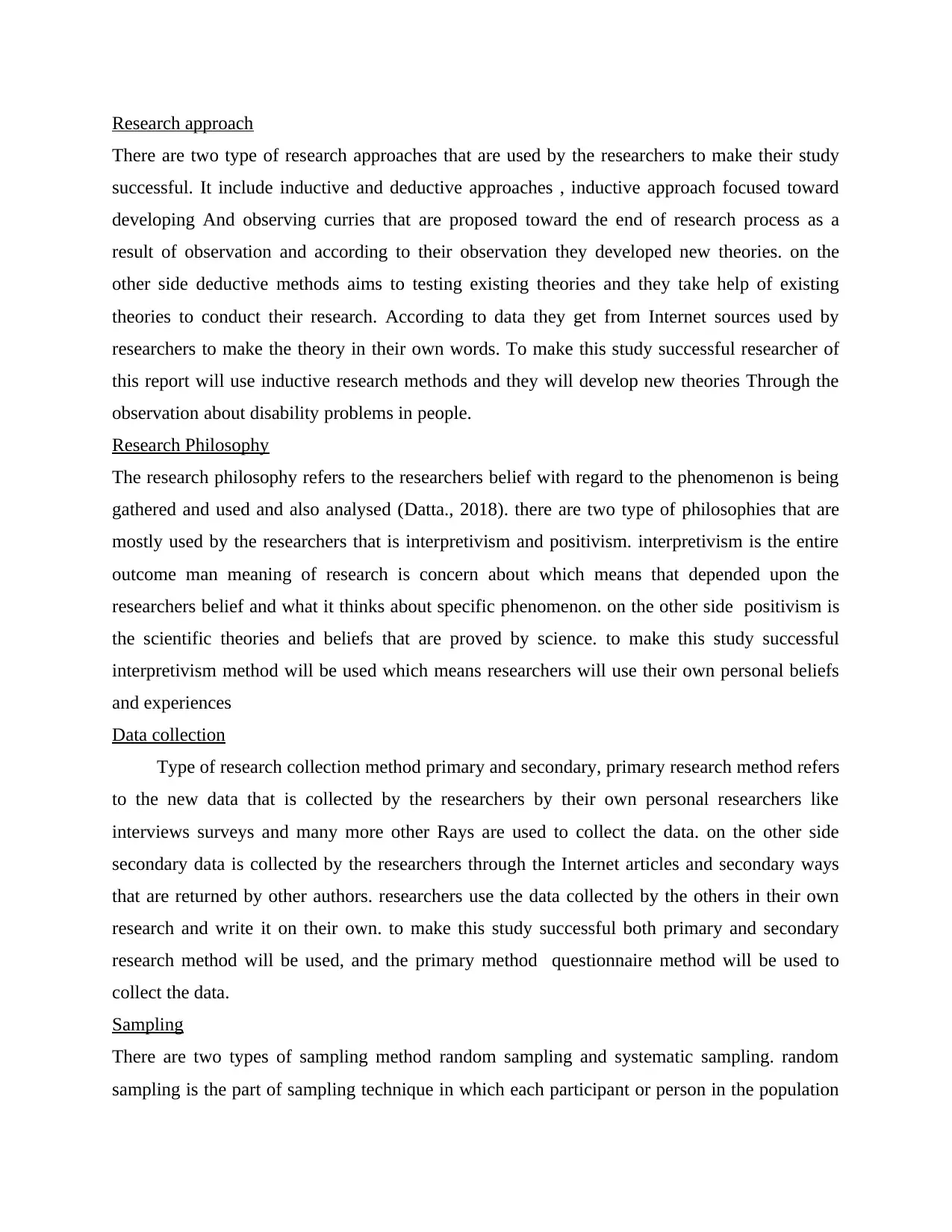
Research approach
There are two type of research approaches that are used by the researchers to make their study
successful. It include inductive and deductive approaches , inductive approach focused toward
developing And observing curries that are proposed toward the end of research process as a
result of observation and according to their observation they developed new theories. on the
other side deductive methods aims to testing existing theories and they take help of existing
theories to conduct their research. According to data they get from Internet sources used by
researchers to make the theory in their own words. To make this study successful researcher of
this report will use inductive research methods and they will develop new theories Through the
observation about disability problems in people.
Research Philosophy
The research philosophy refers to the researchers belief with regard to the phenomenon is being
gathered and used and also analysed (Datta., 2018). there are two type of philosophies that are
mostly used by the researchers that is interpretivism and positivism. interpretivism is the entire
outcome man meaning of research is concern about which means that depended upon the
researchers belief and what it thinks about specific phenomenon. on the other side positivism is
the scientific theories and beliefs that are proved by science. to make this study successful
interpretivism method will be used which means researchers will use their own personal beliefs
and experiences
Data collection
Type of research collection method primary and secondary, primary research method refers
to the new data that is collected by the researchers by their own personal researchers like
interviews surveys and many more other Rays are used to collect the data. on the other side
secondary data is collected by the researchers through the Internet articles and secondary ways
that are returned by other authors. researchers use the data collected by the others in their own
research and write it on their own. to make this study successful both primary and secondary
research method will be used, and the primary method questionnaire method will be used to
collect the data.
Sampling
There are two types of sampling method random sampling and systematic sampling. random
sampling is the part of sampling technique in which each participant or person in the population
There are two type of research approaches that are used by the researchers to make their study
successful. It include inductive and deductive approaches , inductive approach focused toward
developing And observing curries that are proposed toward the end of research process as a
result of observation and according to their observation they developed new theories. on the
other side deductive methods aims to testing existing theories and they take help of existing
theories to conduct their research. According to data they get from Internet sources used by
researchers to make the theory in their own words. To make this study successful researcher of
this report will use inductive research methods and they will develop new theories Through the
observation about disability problems in people.
Research Philosophy
The research philosophy refers to the researchers belief with regard to the phenomenon is being
gathered and used and also analysed (Datta., 2018). there are two type of philosophies that are
mostly used by the researchers that is interpretivism and positivism. interpretivism is the entire
outcome man meaning of research is concern about which means that depended upon the
researchers belief and what it thinks about specific phenomenon. on the other side positivism is
the scientific theories and beliefs that are proved by science. to make this study successful
interpretivism method will be used which means researchers will use their own personal beliefs
and experiences
Data collection
Type of research collection method primary and secondary, primary research method refers
to the new data that is collected by the researchers by their own personal researchers like
interviews surveys and many more other Rays are used to collect the data. on the other side
secondary data is collected by the researchers through the Internet articles and secondary ways
that are returned by other authors. researchers use the data collected by the others in their own
research and write it on their own. to make this study successful both primary and secondary
research method will be used, and the primary method questionnaire method will be used to
collect the data.
Sampling
There are two types of sampling method random sampling and systematic sampling. random
sampling is the part of sampling technique in which each participant or person in the population
Paraphrase This Document
Need a fresh take? Get an instant paraphrase of this document with our AI Paraphraser
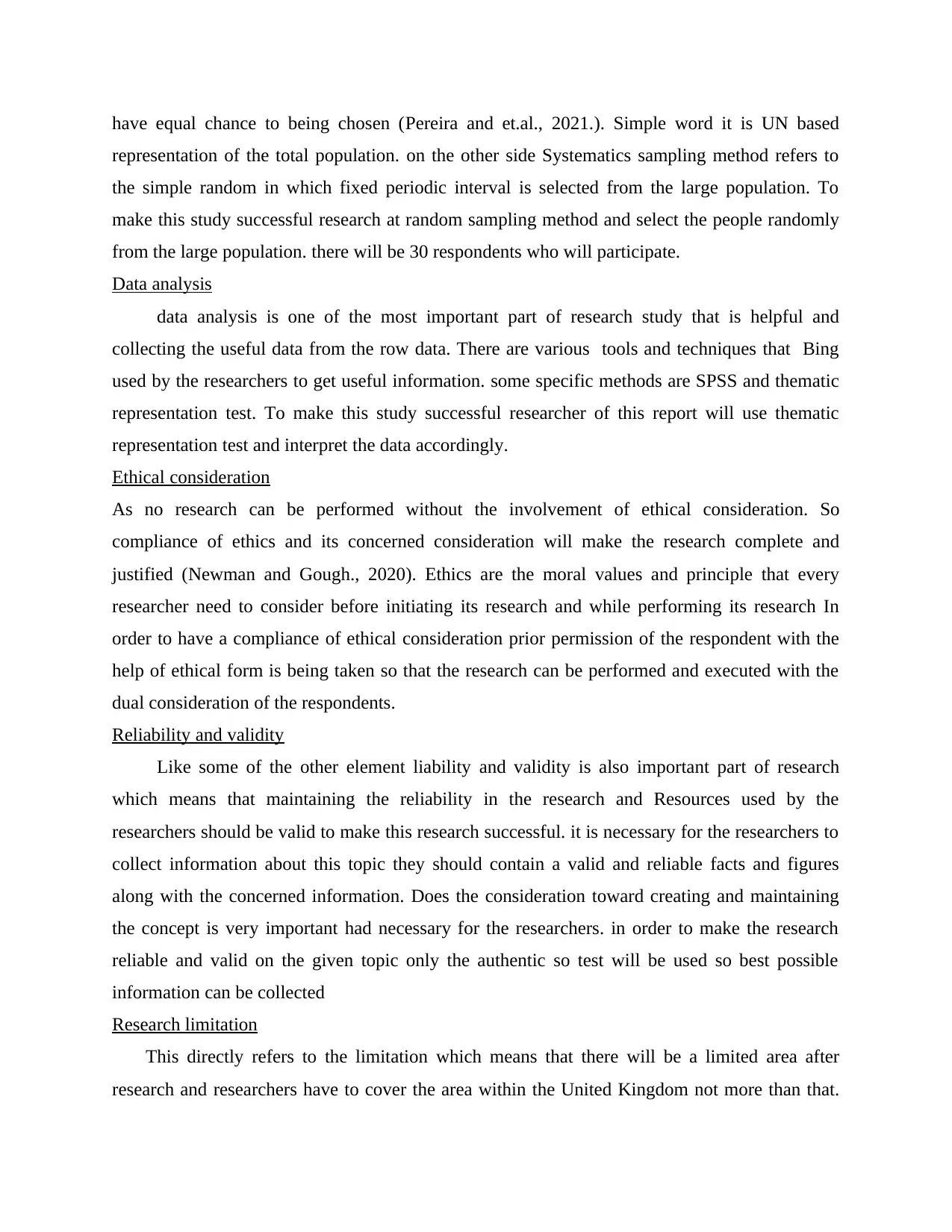
have equal chance to being chosen (Pereira and et.al., 2021.). Simple word it is UN based
representation of the total population. on the other side Systematics sampling method refers to
the simple random in which fixed periodic interval is selected from the large population. To
make this study successful research at random sampling method and select the people randomly
from the large population. there will be 30 respondents who will participate.
Data analysis
data analysis is one of the most important part of research study that is helpful and
collecting the useful data from the row data. There are various tools and techniques that Bing
used by the researchers to get useful information. some specific methods are SPSS and thematic
representation test. To make this study successful researcher of this report will use thematic
representation test and interpret the data accordingly.
Ethical consideration
As no research can be performed without the involvement of ethical consideration. So
compliance of ethics and its concerned consideration will make the research complete and
justified (Newman and Gough., 2020). Ethics are the moral values and principle that every
researcher need to consider before initiating its research and while performing its research In
order to have a compliance of ethical consideration prior permission of the respondent with the
help of ethical form is being taken so that the research can be performed and executed with the
dual consideration of the respondents.
Reliability and validity
Like some of the other element liability and validity is also important part of research
which means that maintaining the reliability in the research and Resources used by the
researchers should be valid to make this research successful. it is necessary for the researchers to
collect information about this topic they should contain a valid and reliable facts and figures
along with the concerned information. Does the consideration toward creating and maintaining
the concept is very important had necessary for the researchers. in order to make the research
reliable and valid on the given topic only the authentic so test will be used so best possible
information can be collected
Research limitation
This directly refers to the limitation which means that there will be a limited area after
research and researchers have to cover the area within the United Kingdom not more than that.
representation of the total population. on the other side Systematics sampling method refers to
the simple random in which fixed periodic interval is selected from the large population. To
make this study successful research at random sampling method and select the people randomly
from the large population. there will be 30 respondents who will participate.
Data analysis
data analysis is one of the most important part of research study that is helpful and
collecting the useful data from the row data. There are various tools and techniques that Bing
used by the researchers to get useful information. some specific methods are SPSS and thematic
representation test. To make this study successful researcher of this report will use thematic
representation test and interpret the data accordingly.
Ethical consideration
As no research can be performed without the involvement of ethical consideration. So
compliance of ethics and its concerned consideration will make the research complete and
justified (Newman and Gough., 2020). Ethics are the moral values and principle that every
researcher need to consider before initiating its research and while performing its research In
order to have a compliance of ethical consideration prior permission of the respondent with the
help of ethical form is being taken so that the research can be performed and executed with the
dual consideration of the respondents.
Reliability and validity
Like some of the other element liability and validity is also important part of research
which means that maintaining the reliability in the research and Resources used by the
researchers should be valid to make this research successful. it is necessary for the researchers to
collect information about this topic they should contain a valid and reliable facts and figures
along with the concerned information. Does the consideration toward creating and maintaining
the concept is very important had necessary for the researchers. in order to make the research
reliable and valid on the given topic only the authentic so test will be used so best possible
information can be collected
Research limitation
This directly refers to the limitation which means that there will be a limited area after
research and researchers have to cover the area within the United Kingdom not more than that.
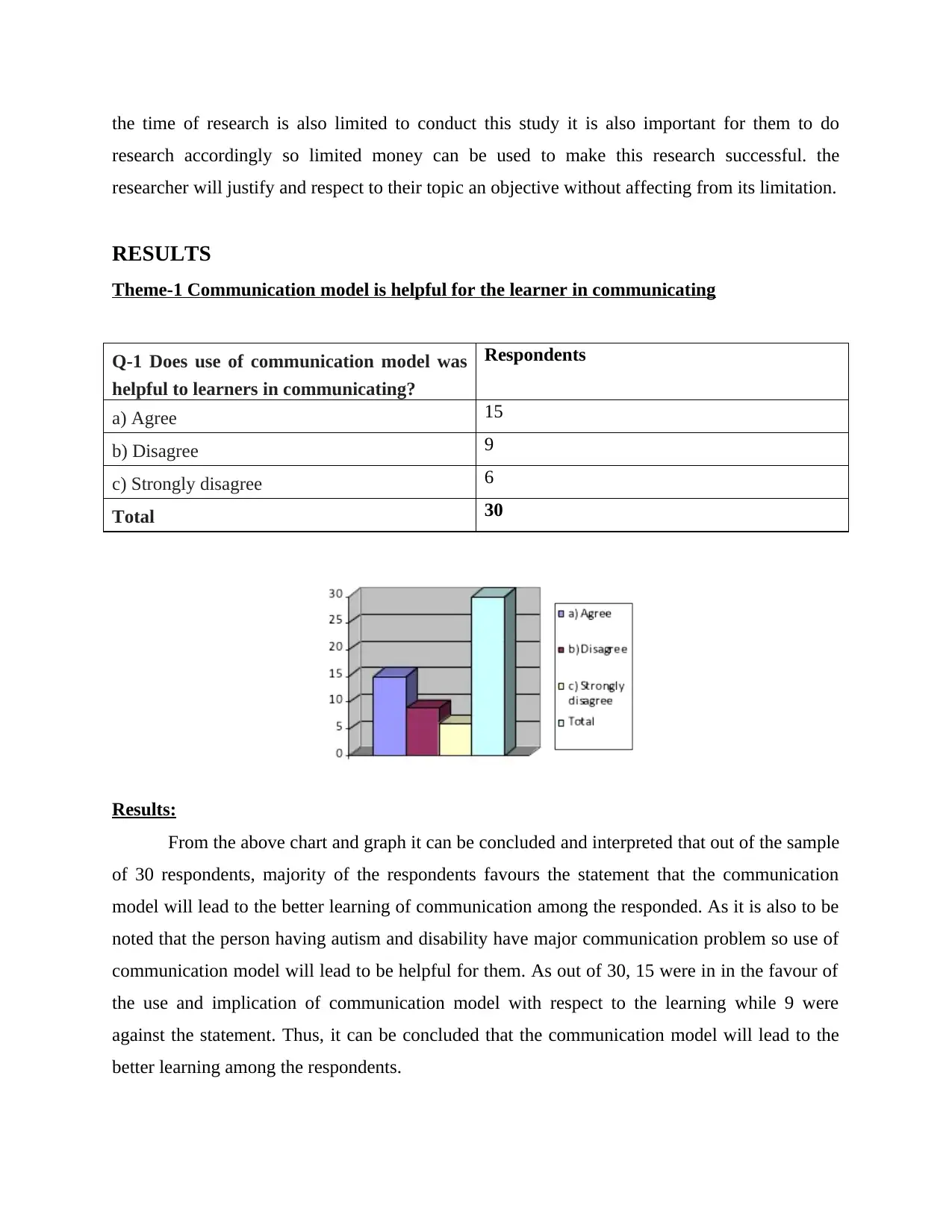
the time of research is also limited to conduct this study it is also important for them to do
research accordingly so limited money can be used to make this research successful. the
researcher will justify and respect to their topic an objective without affecting from its limitation.
RESULTS
Theme-1 Communication model is helpful for the learner in communicating
Q-1 Does use of communication model was
helpful to learners in communicating?
Respondents
a) Agree 15
b) Disagree 9
c) Strongly disagree 6
Total 30
Results:
From the above chart and graph it can be concluded and interpreted that out of the sample
of 30 respondents, majority of the respondents favours the statement that the communication
model will lead to the better learning of communication among the responded. As it is also to be
noted that the person having autism and disability have major communication problem so use of
communication model will lead to be helpful for them. As out of 30, 15 were in in the favour of
the use and implication of communication model with respect to the learning while 9 were
against the statement. Thus, it can be concluded that the communication model will lead to the
better learning among the respondents.
research accordingly so limited money can be used to make this research successful. the
researcher will justify and respect to their topic an objective without affecting from its limitation.
RESULTS
Theme-1 Communication model is helpful for the learner in communicating
Q-1 Does use of communication model was
helpful to learners in communicating?
Respondents
a) Agree 15
b) Disagree 9
c) Strongly disagree 6
Total 30
Results:
From the above chart and graph it can be concluded and interpreted that out of the sample
of 30 respondents, majority of the respondents favours the statement that the communication
model will lead to the better learning of communication among the responded. As it is also to be
noted that the person having autism and disability have major communication problem so use of
communication model will lead to be helpful for them. As out of 30, 15 were in in the favour of
the use and implication of communication model with respect to the learning while 9 were
against the statement. Thus, it can be concluded that the communication model will lead to the
better learning among the respondents.
⊘ This is a preview!⊘
Do you want full access?
Subscribe today to unlock all pages.

Trusted by 1+ million students worldwide
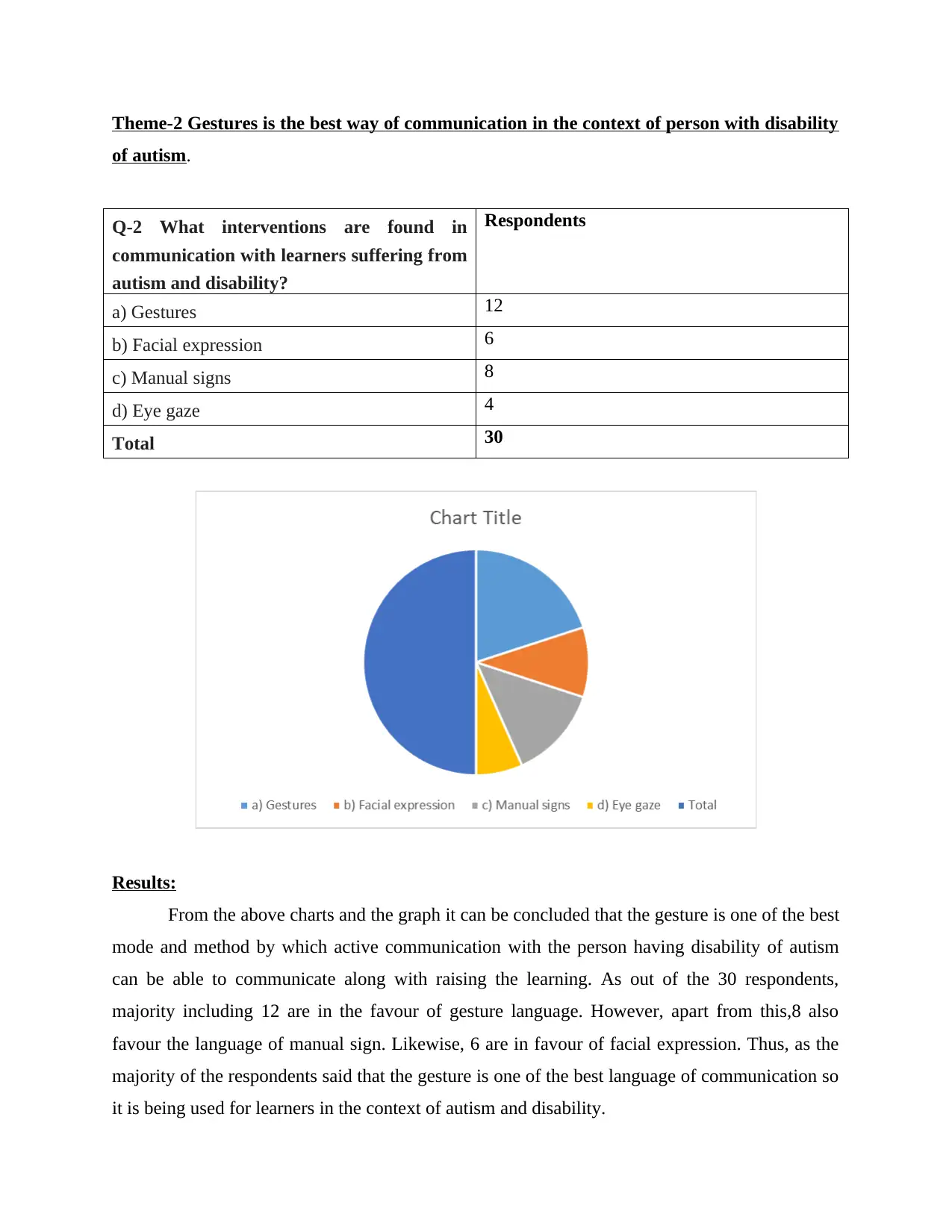
Theme-2 Gestures is the best way of communication in the context of person with disability
of autism.
Q-2 What interventions are found in
communication with learners suffering from
autism and disability?
Respondents
a) Gestures 12
b) Facial expression 6
c) Manual signs 8
d) Eye gaze 4
Total 30
Results:
From the above charts and the graph it can be concluded that the gesture is one of the best
mode and method by which active communication with the person having disability of autism
can be able to communicate along with raising the learning. As out of the 30 respondents,
majority including 12 are in the favour of gesture language. However, apart from this,8 also
favour the language of manual sign. Likewise, 6 are in favour of facial expression. Thus, as the
majority of the respondents said that the gesture is one of the best language of communication so
it is being used for learners in the context of autism and disability.
of autism.
Q-2 What interventions are found in
communication with learners suffering from
autism and disability?
Respondents
a) Gestures 12
b) Facial expression 6
c) Manual signs 8
d) Eye gaze 4
Total 30
Results:
From the above charts and the graph it can be concluded that the gesture is one of the best
mode and method by which active communication with the person having disability of autism
can be able to communicate along with raising the learning. As out of the 30 respondents,
majority including 12 are in the favour of gesture language. However, apart from this,8 also
favour the language of manual sign. Likewise, 6 are in favour of facial expression. Thus, as the
majority of the respondents said that the gesture is one of the best language of communication so
it is being used for learners in the context of autism and disability.
Paraphrase This Document
Need a fresh take? Get an instant paraphrase of this document with our AI Paraphraser
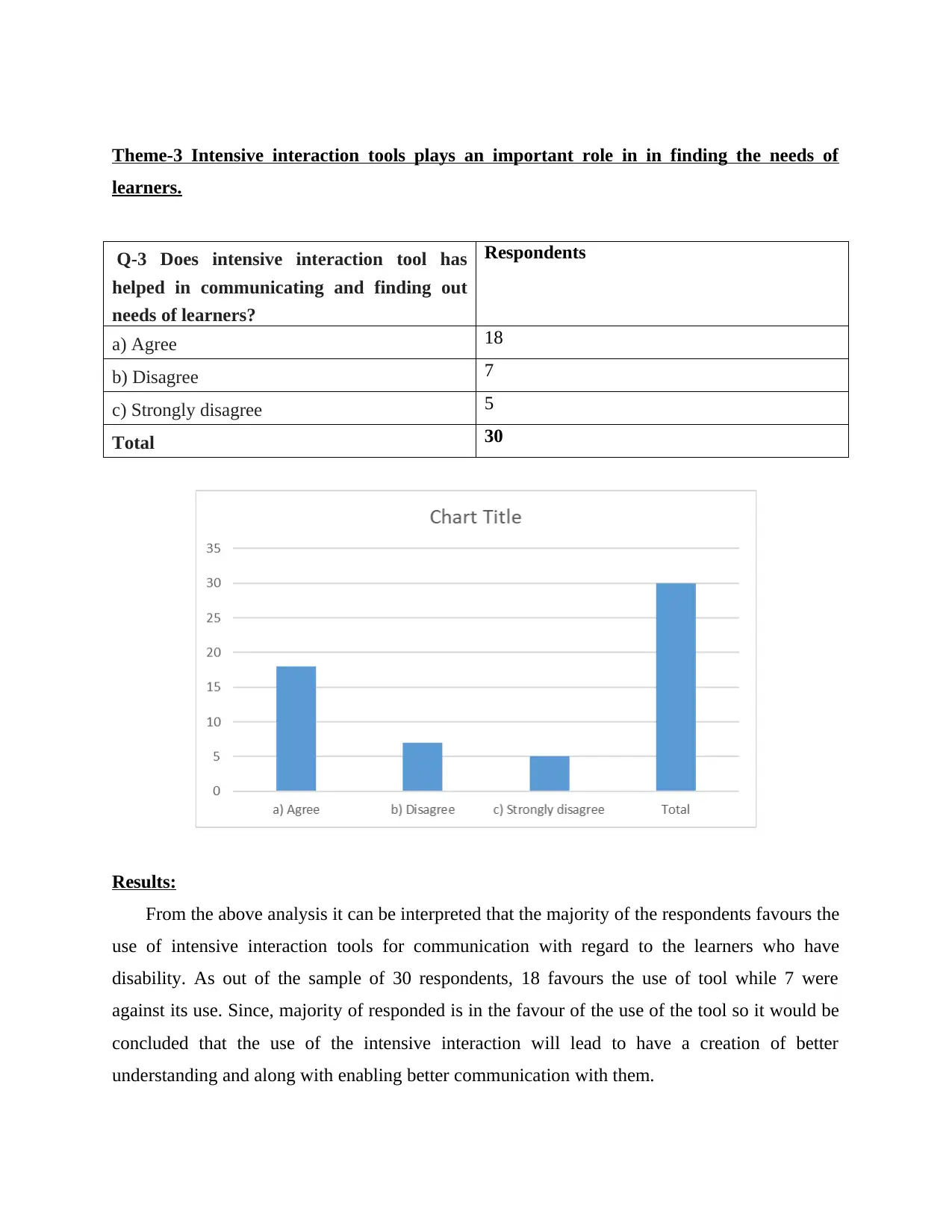
Theme-3 Intensive interaction tools plays an important role in in finding the needs of
learners.
Q-3 Does intensive interaction tool has
helped in communicating and finding out
needs of learners?
Respondents
a) Agree 18
b) Disagree 7
c) Strongly disagree 5
Total 30
Results:
From the above analysis it can be interpreted that the majority of the respondents favours the
use of intensive interaction tools for communication with regard to the learners who have
disability. As out of the sample of 30 respondents, 18 favours the use of tool while 7 were
against its use. Since, majority of responded is in the favour of the use of the tool so it would be
concluded that the use of the intensive interaction will lead to have a creation of better
understanding and along with enabling better communication with them.
learners.
Q-3 Does intensive interaction tool has
helped in communicating and finding out
needs of learners?
Respondents
a) Agree 18
b) Disagree 7
c) Strongly disagree 5
Total 30
Results:
From the above analysis it can be interpreted that the majority of the respondents favours the
use of intensive interaction tools for communication with regard to the learners who have
disability. As out of the sample of 30 respondents, 18 favours the use of tool while 7 were
against its use. Since, majority of responded is in the favour of the use of the tool so it would be
concluded that the use of the intensive interaction will lead to have a creation of better
understanding and along with enabling better communication with them.
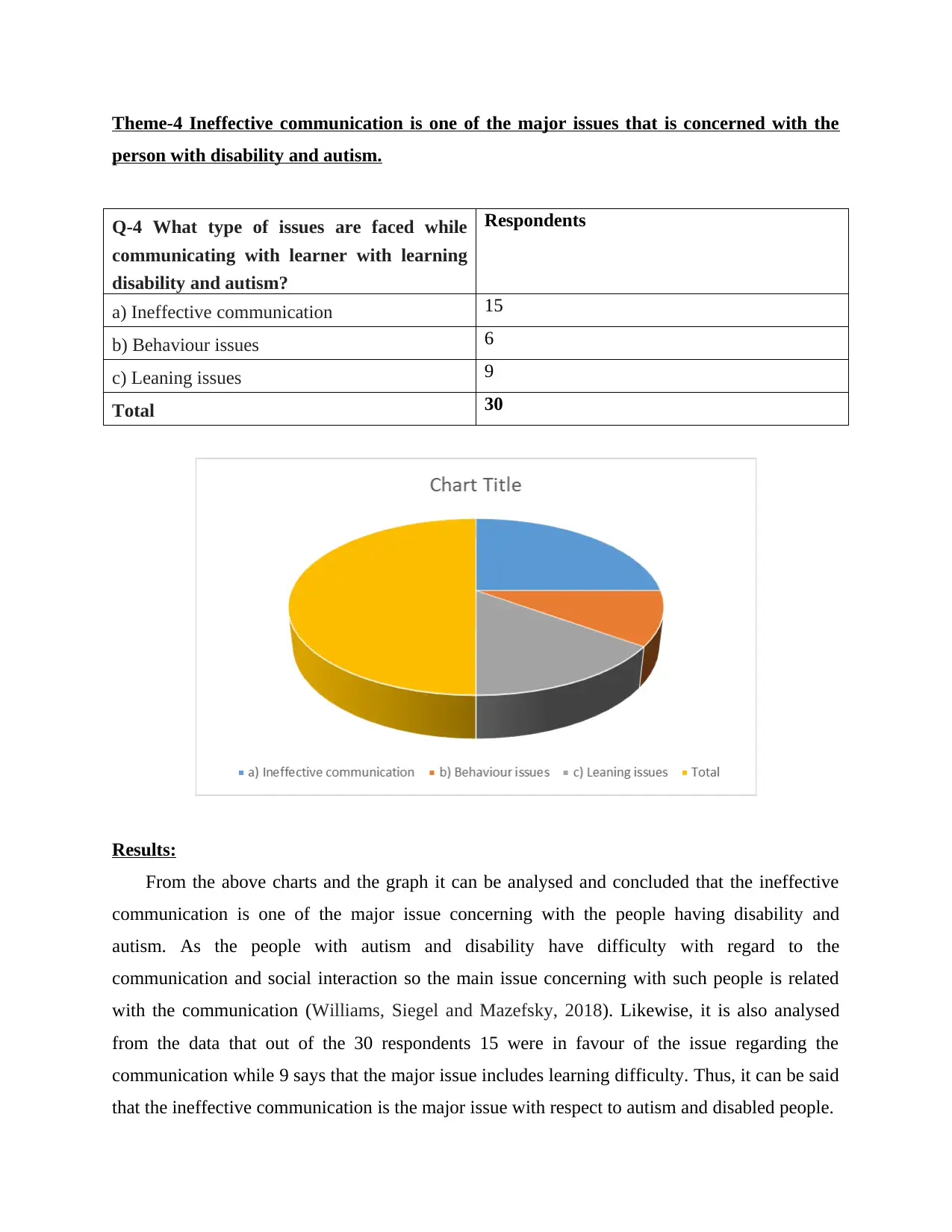
Theme-4 Ineffective communication is one of the major issues that is concerned with the
person with disability and autism.
Q-4 What type of issues are faced while
communicating with learner with learning
disability and autism?
Respondents
a) Ineffective communication 15
b) Behaviour issues 6
c) Leaning issues 9
Total 30
Results:
From the above charts and the graph it can be analysed and concluded that the ineffective
communication is one of the major issue concerning with the people having disability and
autism. As the people with autism and disability have difficulty with regard to the
communication and social interaction so the main issue concerning with such people is related
with the communication (Williams, Siegel and Mazefsky, 2018). Likewise, it is also analysed
from the data that out of the 30 respondents 15 were in favour of the issue regarding the
communication while 9 says that the major issue includes learning difficulty. Thus, it can be said
that the ineffective communication is the major issue with respect to autism and disabled people.
person with disability and autism.
Q-4 What type of issues are faced while
communicating with learner with learning
disability and autism?
Respondents
a) Ineffective communication 15
b) Behaviour issues 6
c) Leaning issues 9
Total 30
Results:
From the above charts and the graph it can be analysed and concluded that the ineffective
communication is one of the major issue concerning with the people having disability and
autism. As the people with autism and disability have difficulty with regard to the
communication and social interaction so the main issue concerning with such people is related
with the communication (Williams, Siegel and Mazefsky, 2018). Likewise, it is also analysed
from the data that out of the 30 respondents 15 were in favour of the issue regarding the
communication while 9 says that the major issue includes learning difficulty. Thus, it can be said
that the ineffective communication is the major issue with respect to autism and disabled people.
⊘ This is a preview!⊘
Do you want full access?
Subscribe today to unlock all pages.

Trusted by 1+ million students worldwide
1 out of 21
Your All-in-One AI-Powered Toolkit for Academic Success.
+13062052269
info@desklib.com
Available 24*7 on WhatsApp / Email
![[object Object]](/_next/static/media/star-bottom.7253800d.svg)
Unlock your academic potential
Copyright © 2020–2025 A2Z Services. All Rights Reserved. Developed and managed by ZUCOL.